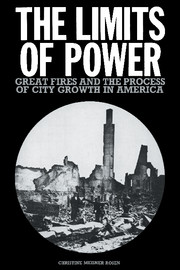Book contents
6 - The rebuilding of Chicago
Published online by Cambridge University Press: 22 September 2009
Summary
The great Chicago fire was one of the worst urban conflagrations in history. It began shortly after nine o'clock, Sunday evening, October 8, 1871, in a small, wooden barn on DeKoven Street owned by the O'Leary family. Contemporaries generally believed that it was started by an angry, unmilked cow that kicked over a kerosene lamp and set a barn ablaze, but no one knows how it really began. All that is certain is that once begun, it quickly overwhelmed the Fire Department and swept across the city like a storm. Fed by wooden buildings dried out by months of drought, and propelled by strong winds and tornadolike convection currents, it roared across the city's wooden streets and down its wooden sidewalks, demolishing an average of sixty-five acres of buildings every hour, approximately $125,000 worth of property every minute, for twenty-seven hours.
It shut down the water works early Monday morning and burned out of control until a rainstorm finally put it out about midnight Monday night. In the process it reduced close to four square miles of the city (see Figure 6.1) to smoking rubble, including the city's entire central commercial district, many of its finest middle and upper class neighborhoods, and acres upon acres of working class cottages and shanties. It ruined approximately $200 million worth of property, including 8 bridges, 15,000 water service pipes, 121 miles of sidewalks, 80 business blocks, several hundred warehouses, a number of hotels, theaters, churches, and railway depots, and roughly 16,000 other buildings.
- Type
- Chapter
- Information
- The Limits of PowerGreat Fires and the Process of City Growth in America, pp. 92 - 176Publisher: Cambridge University PressPrint publication year: 1986



